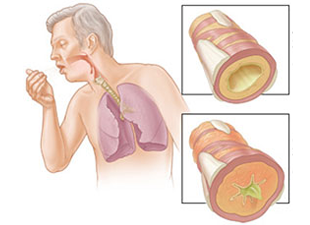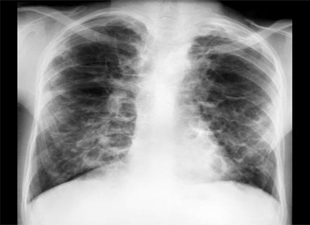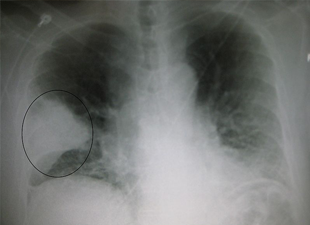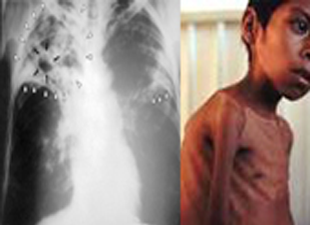
Asthma
Asthma is a chronic condition in which airways narrow and swell and produce extra mucus. This can make breathing difficult and trigger coughing, wheezing and shortness of breath.
For some people, asthma is a minor problem and for others, it can be a major problem that interferes with daily activities and may lead to a life-threatening asthma attack.
Asthma can’t be cured, but its symptoms can be controlled. Because asthma often changes over time, it’s important that you work with your doctor to track your signs and symptoms and adjust treatment as needed .

Allergic Rhinitis
The prevalence of asthma and rhinitis is increasing worldwide. Environmental factors are mostly thought to be responsible. Both diseases frequently coexist in the same patients, with asthma present in 20–50% of patients with allergic rhinitis and rhinitis present in up to 80% of patients with asthma
Allergic rhinitis is inflammation and swelling of the mucous membrane of the nose, characterized by a runny nose and stuffiness and caused by an allergy Allergic rhinitis is often accompanied by significant co-morbidities that includes allergic conjunctivitis, sinusitis, eustachian tube dysfunction, ear infections, and/or asthma Atopic dermatitis is also frequently associated with allergic rhinitis in children and adults.
Diagnosis of allergy may be obvious when symptoms recur seasonally. However, reactions to perennial allergens often require a careful history, physical exam and special allergy tests to make a correct diagnosis and optimize treatment.

Bronchitis
Bronchitis is an inflammation of the lining of bronchial tubes, which carry air to and from your lungs. People who have bronchitis often cough up thickened mucus, which can be discolored. Bronchitis may be either acute or chronic.
Often developing from a cold or other respiratory infection, acute bronchitis is very common. Chronic bronchitis, a more serious condition, is a constant irritation or inflammation of the lining of the bronchial tubes, often due to smoking.
Acute bronchitis usually improves within a few days without lasting effects, although the cough may continue for weeks. However, if you have repeated bouts of bronchitis, you may have chronic bronchitis, which requires medical attention. Chronic bronchitis is one of the conditions included in chronic obstructive pulmonary disease (COPD).

COPD
Chronic obstructive pulmonary disease (COPD), a common preventable and treatable disease, is characterized by airflow limitation that is usually progressive and associated with an enhanced chronic inflammatory response in the airways and the lung to noxious particles or gases. Exacerbations and comorbidities contribute to the overall severity in individual patients.” … read more (Are you at risk?)
Chronic bronchitis— chronic bronchitis is defined as a chronic productive cough for three months in each of two successive years in a patient in whom other causes of chronic cough (eg, bronchiectasis) have been excluded. It may precede or follow development of airflow limitation. This definition has been used in many studies, despite the arbitrarily selected symptom duration.
Emphysema— Emphysema is defined by abnormal and permanent enlargement of the airspaces distal to the terminal bronchioles that is accompanied by destruction of the airspace walls, without obvious fibrosis (ie, there is no fibrosis visible to the naked eye). Exclusion of obvious fibrosis was intended to distinguish the alveolar destruction due to emphysema from that due to the interstitial pneumonias. However, many studies have found increased collagen in the lungs of patients with mild COPD, indicating that fibrosis can be a component of emphysema. While emphysema can exist in individuals who do not have airflow obstruction, it is more common among patients who have moderate or severe airflow obstruction.

Bronchiectasis
Bronchiectasis is a long-term condition where the airways of the lungs become abnormally widened, leading to a build-up of excess mucus that can make the lungs more vulnerable to infection.
The most common symptoms of bronchiectasis include:
A persistent cough that usually brings up phlegm (sputum)
breathlessness
The severity of symptoms can vary widely. Some people have only a few symptoms that don’t appear often, while others have wide-ranging symptoms that occur daily.
The symptoms tend to get worse if you develop an infection in your lungs.

Pneumonia
Pneumonia is an infection that inflames the air sacs in one or both lungs. The air sacs may fill with fluid or pus (purulent material), causing cough with phlegm or pus, fever, chills, and difficulty breathing. A variety of organisms, including bacteria, viruses and fungi, can cause pneumonia.
Pneumonia can range in seriousness from mild to life-threatening It is most serious for infants and young children, people older than age 65, and people with health problems or weakened immune systems.
The signs and symptoms of pneumonia vary from mild to severe, depending on factors such as the type of germ causing the infection, and your age and overall health. Mild signs and symptoms often are similar to those of a cold or flu, but they last longer.
Signs and symptoms of pneumonia may include:
Fever, sweating and shaking chills
Cough, which may produce phlegm.
Chest pain when you breathe or cough
Shortness of breath
Fatigue
Nausea, vomiting or diarrhea

Tuberculosis
Tuberculosis, commonly known as TB, is a contagious caused by the bacterium called Mycobacterium tuberculosis and an often severe airborne disease. TB typically affects the lungs, but it also may affect any other organ of the body. It is usually treated with a regimen of drugs taken for 6 months to 2 years, depending on the type of infection.
Interstitial Lung Disease
Interstitial lung disease includes a group of diseases that have thickening of thesupporting tissues between the air sacs of the lungs as the common factor. The interstitium is a thin layer of tissue that is normally appears as a fine lace on X-rays or imaging studies (best visualized as the appearance of a
